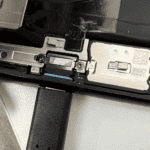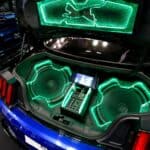Testing car audio equipment outside of a vehicle can be tricky. But it’s a useful skill for DIY enthusiasts and audio professionals alike. You can test an amp and subwoofer without a car using a power supply, audio source, and speaker wire.
This method lets you check your gear before installation. It also helps when troubleshooting issues or buying used equipment. With the right setup, you can connect the amplifier to a power source and test its output.
Safety comes first when working with audio equipment. Always follow proper procedures and use caution with electrical connections. With care and the right tools, testing your amp and sub at home is easy and informative.
🧰 What You’ll Need
- 12V DC power supply (rated for at least 10–30 amps, depending on your amp’s power requirements)
- Multimeter
- Speaker wire
- RCA cable (if testing input signal)
- Audio source (like a phone or MP3 player with a 3.5mm-to-RCA adapter)
- Test speaker or subwoofer
- Inline fuse (recommended for safety)
🔌 Part 1: Testing the Amplifier Without a Car
Step 1: Set Up a Power Source
- Use a regulated 12V DC power supply — this substitutes for your car’s battery.
- Connect:
- +12V terminal of the amp to the positive output of the power supply.
- Ground (GND) terminal to the negative output.
- Remote turn-on (REM) wire to the +12V terminal (this “tells” the amp to turn on).
- Double-check connections before powering on — incorrect polarity can damage the amp.
💡 Tip: You can use a 12V car battery if you don’t have a bench power supply, but be sure to include a fuse inline with the positive wire.
Step 2: Verify Power with a Multimeter
- Before connecting speakers, power on the supply and use a multimeter to confirm:
- Voltage between +12V and GND is around 12–14V.
- The amp’s power indicator light turns on.
If there’s no light or voltage, recheck wiring and the fuse.
Step 3: Connect an Audio Source
- Plug your RCA cables from your audio device (via a 3.5mm-to-RCA adapter if needed) into the amp’s input.
- Set the amp’s gain low to start.
Step 4: Connect a Test Speaker or Subwoofer
- Connect the amp’s speaker output terminals to your test subwoofer or another speaker.
- Ensure polarity is correct (+ to +, – to –).
- Play audio at a low volume and gradually increase gain.
If you hear clean sound, your amplifier is working properly. Distortion, noise, or silence may indicate internal issues.
🔊 Part 2: Testing the Subwoofer Without an Amp
If you want to test the subwoofer alone, you can check both electrical and mechanical health.
Step 1: Check Voice Coil with a Multimeter
- Set the multimeter to ohms (Ω).
- Touch the probes to the sub’s positive and negative terminals.
- Typical readings:
- Single 4-ohm sub: around 3.5–4.5Ω
- Dual 2-ohm sub: each coil around 1.8–2.2Ω
If the reading is 0Ω (short) or infinite (open), the sub is likely blown.
(Source: Car News Box)
Step 2: Manual Cone Test
Gently press the subwoofer cone with your fingers:
- It should move smoothly and spring back evenly.
- Scratching or grinding sounds indicate a damaged voice coil.
Step 3: Quick Power Test (Optional)
You can briefly test the sub by connecting it to a low-power audio source:
- Use a 9V battery or a small home stereo output.
- Touch the battery terminals to the sub’s terminals — the cone should move slightly (“pop”).
- Don’t hold it continuously — this is just a quick check.
(Source: Auto Stereo Guide)
⚠️ Safety Tips
- Always include a fuse between your power source and amp.
- Avoid touching live terminals.
- Never run the amp at high power without a proper load (speaker/sub connected).
- Keep volume low during tests to prevent damage.
✅ Summary
| Component | Test Method | Tools Needed | What to Look For |
|---|---|---|---|
| Amplifier | Power + RCA + Speaker Test | 12V PSU, multimeter | Power light, clean sound |
| Subwoofer | Resistance + Cone + Battery Pop | Multimeter, 9V battery | Smooth movement, correct ohms |
Key Takeaways
- Testing car audio gear outside a vehicle is possible with basic tools
- A power supply, audio source, and speaker wire are essential for the setup
- Safety precautions are crucial when handling electrical components
Basics of Amp and Subwoofer Testing
Testing amps and subs outside a car requires knowledge of their functions and proper setup. This ensures accurate results and helps identify any issues with the audio components.
Understanding Amplifier and Subwoofer Functions
An amp boosts weak audio signals. It makes them strong enough to power speakers. A subwoofer handles low-frequency sounds like bass. Together they create deep rich sound in car audio systems.
Amps have several key parts:
- Input connections
- Power supply
- Output terminals
Subwoofers have these main components:
- Cone
- Voice coil
- Magnet
Knowing how these parts work helps with testing. It allows testers to check each element for problems.
Preparation for Testing
Before testing set up a proper workspace. Gather all needed tools and equipment.
Essential items for testing include:
- Multimeter
- Power supply
- Audio source (phone or music player)
- Speaker wire
- Test tones
Make sure the area is clean and dry. Keep all tools organized and within reach. This speeds up the testing process.
Connect the amp to a power supply. Then link it to the subwoofer with speaker wire. Use an audio source to send test signals through the system.
Start with low volume. Gradually increase it while checking for odd sounds or distortion. This method helps find issues without risking damage to the equipment.
Step-by-Step Testing Procedures
Testing an amp and subwoofer outside of a car requires specific methods. These procedures help check if the equipment works properly. They also find potential issues.
Using a Multimeter for Impedance Testing
Impedance testing is key for subwoofer health. Set the multimeter to measure ohms. Connect the probes to the subwoofer terminals. The reading should match the sub’s rated impedance.
For single voice coil subs, one measurement is enough. Dual voice coil subs need two tests. Test each coil separately. A reading far from the rated value may indicate a problem.
Normal readings are usually 2, 4, or 8 ohms. Very low or infinite readings suggest issues. Low resistance might mean shorted coils. Infinite resistance could indicate an open circuit.
Applying a 9V Battery Test
The 9V battery test is simple but effective. It checks if the subwoofer moves. Connect the battery’s positive terminal to the sub’s positive terminal. Do the same for the negative terminals.
A working sub will make a popping sound. The cone should also move. No sound or movement may mean a problem. Be careful not to leave the battery connected for long. It can damage the sub.
This test works for both single and dual voice coil subs. For dual coils, test each coil separately. A failed test on either coil suggests issues.
Assessing Sound Quality and Distortion
Sound quality tests need a test tone generator. Use it to play different frequencies through the sub. Listen for clear, undistorted sound. Watch for smooth cone movement.
Start with low volumes. Gradually increase the volume. Note when distortion begins. Good subs handle higher volumes without distortion. Rattling or buzzing sounds indicate problems.
Test different frequencies. Focus on the sub’s rated range. Most car subs work best from 20 to 200 Hz. Check how the sub performs across this range.
Troubleshooting Common Issues
No sound is a common problem. Check all connections first. Ensure the amp is getting power. Verify the sub is properly connected.
Weak bass can have several causes. It might be a blown subwoofer. Or the amp might not provide enough power. Check the amp’s settings and wiring.
Distorted sound often means the amp is overdriving the sub. Lower the gain on the amp. Also, check if the sub can handle the amp’s power output.
Intermittent sound suggests loose connections. Inspect all wiring. Look for frayed wires or loose terminals. Secure any loose connections.
Frequently Asked Questions
Testing car audio equipment outside a vehicle requires some simple tools and methods. These FAQs cover key techniques for checking amps and subs at home.
How to test a subwoofer without hooking it up?
You can test a subwoofer without connecting it to an amp. Use a 9V battery to check if the voice coil moves. Touch the positive and negative terminals of the battery to the sub’s terminals. The cone should move slightly if it works.
Can you test a car subwoofer at home, and if so, how?
Yes, you can test a car subwoofer at home. Use a home stereo receiver or amplifier. Connect the sub to the amp’s outputs. Play music with bass to check the sound. Make sure to match the power ratings.
What is the proper way to test a subwoofer with a multimeter?
To test a sub with a multimeter set it to ohms. Touch the probes to the sub’s terminals. The reading should match the sub’s rated impedance. A reading of infinity means an open circuit. Zero ohms indicates a short.
How to determine if a subwoofer is functional using a 9v battery?
Connect a 9V battery to the subwoofer. Touch the positive terminal to the sub’s positive and negative to negative. The cone should move in one direction. Reverse the connections and it should move the other way. This shows the voice coil works.
How can you tell if your car’s amplifier or subwoofer is blown?
Signs of a blown amp or sub include no sound distorted audio or a burning smell. Check for visible damage to the cone or surrounds. Test the sub’s resistance with a multimeter. An amp with no output may have blown fuses or failed components.
What are the steps to test an amplifier to ensure it is working correctly?
To test an amp connect a power supply and speakers. Use a sound source like a phone. Turn on the amp and play music. Check for clean sound at various volumes. Test all channels. Look for any error lights or unusual noises.







